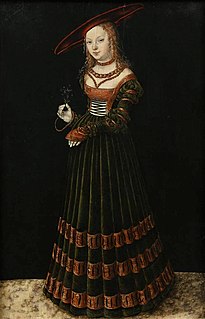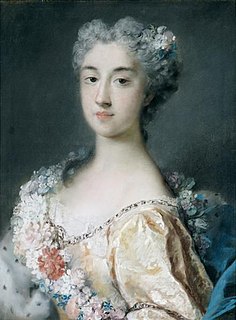Related Research Articles

Year 1540 (MDXL) was a leap year starting on Thursday of the Julian calendar.

Anne of Cleves was Queen of England from 6 January to 9 July 1540 as the fourth wife of King Henry VIII. Not much is known about Anne before 1527, when she became betrothed to Francis, Duke of Bar, son and heir of Antoine, Duke of Lorraine, although their marriage did not proceed. In March 1539, negotiations for Anne's marriage to Henry began, as Henry believed that he needed to form a political alliance with her brother, William, who was a leader of the Protestants of western Germany, to strengthen his position against potential attacks from Catholic France and the Holy Roman Empire.

Mary of Modena was Queen of England, Scotland, and Ireland as the second wife of James II and VII (1633–1701). A devout Roman Catholic, Mary married the widower James, who was then the younger brother and heir presumptive of Charles II (1630–1685). She was uninterested in politics and devoted to James and their children, two of whom survived to adulthood: the Jacobite claimant to the thrones, James Francis Edward, and Louisa Maria Teresa.
The Count of Anjou was the ruler of the County of Anjou, first granted by Charles the Bald in the 9th century to Robert the Strong. Ingelger and his son, Fulk the Red, were viscounts until Fulk assumed the title of Count of Anjou. The Robertians and their Capetian successors were distracted by wars with the Vikings and other concerns and were unable to recover the county until the reign of Philip II Augustus, more than 270 years later.

Princess Victoria of Saxe-Coburg-Saalfeld, later Princess of Leiningen and subsequently Duchess of Kent and Strathearn, was a German princess and the mother of Queen Victoria of the United Kingdom. As the widow of Charles, Prince of Leiningen (1763–1814), from 1814 she served as regent of the Principality during the minority of her son from her first marriage, Carl, until her second wedding in 1818 to Prince Edward, fourth son of King George III of the United Kingdom.

Guillaume IV reigned as the Grand Duke of Luxembourg from 17 November 1905 until his death. He succeeded his father, Adolphe.

Princess Victoria Melita of Saxe-Coburg and Gotha, later Grand Duchess Victoria Feodorovna of Russia was the third child and second daughter of Alfred, Duke of Saxe-Coburg and Gotha, and of Grand Duchess Maria Alexandrovna of Russia. She was a granddaughter of Queen Victoria of the United Kingdom and also of Emperor Alexander II of Russia.

Christina of Denmark was a Danish princess, the younger surviving daughter of King Christian II of Denmark and Norway and Isabella of Austria. She became the duchess-consort of Milan, then duchess-consort of Lorraine. She served as the regent of Lorraine from 1545 to 1552 during the minority of her son. She was also a claimant to the thrones of Denmark, Norway and Sweden in 1561–1590. Finally, she was sovereign Lady of Tortona in 1578–1584.
A substantive title is a title of nobility or royalty acquired either by individual grant or inheritance. It is to be distinguished from a title shared among cadets, borne as a courtesy title by a peer's relatives, or acquired through marriage.

Princess Augusta Frederica of Great Britain was a British princess, granddaughter of King George II and the only elder sibling of King George III. She was the duchess of Brunswick-Wolfenbuttel by marriage to Charles William Ferdinand, Duke of Brunswick. Her daughter Caroline was the spouse of King George IV.

Maria of Jülich-Berg was a German heiress. She was born in Jülich, the daughter of Wilhelm IV, Duke of Jülich-Berg and Sibylle of Brandenburg.

La Marck was a noble family, which from about 1200 appeared as the counts of Mark.

Prince Aribert Joseph Alexander of Anhalt was regent of Anhalt from September to November 1918 on behalf of his underage nephew, Duke Joachim Ernst. As regent, following the German revolution, he abdicated in the name of his nephew on 12 November 1918, thus ending the rule of the House of Ascania in Anhalt.

Anna Gonzaga was an Italian French noblewoman and salonist. The youngest daughter of Charles Gonzaga, Duke of Mantua and Montferrat, and Catherine de Mayenne, Anna was "Princess Palatine" as the wife of Edward of the Palatinate, a grandson of King James I of England and uncle to King George I of Great Britain. She bore Edward three children, all daughters. Had Anna not converted Edward to Catholicism, the English throne might have passed to their descendants.

Louise Marie Thérèse d'Artois was a duchess and later a regent of Parma. She was the eldest daughter of Charles Ferdinand, Duke of Berry, younger son of King Charles X of France and Princess Caroline of Naples and Sicily. She served as regent of Parma during the minority of her son from 1854 until 1859.

Infanta Adelgundes, Duchess of Guimarães was the fifth child and fourth daughter of Miguel of Portugal and his wife Adelaide of Löwenstein-Wertheim-Rosenberg. A member of the House of Braganza by birth, Adelgundes became a member of the House of Bourbon-Parma through her marriage to Prince Henry of Bourbon-Parma, Count of Bardi. She was also the Regent of the Monarchic Representation of Portugal and for that reason assumed the title of Duchess of Guimarães, usually reserved for the Head of the House.

Jeanne d'Albret, also known as Jeanne III, was the queen regnant of Navarre from 1555 to 1572. She married Antoine de Bourbon, Duke of Vendôme, becoming the Duchess of Vendôme and was the mother of Henri de Bourbon, who became King Henry III of Navarre and IV of France, the first Bourbon king of France.

Berkhamsted Castle is a Norman motte-and-bailey castle in Berkhamsted, Hertfordshire. The castle was built to obtain control of a key route between London and the Midlands during the Norman conquest of England in the 11th century. Robert of Mortain, William the Conqueror's half brother, was probably responsible for managing its construction, after which he became the castle's owner. The castle was surrounded by protective earthworks and a deer park for hunting. The castle became a new administrative centre of the former Anglo-Saxon settlement of Berkhamsted. Subsequent kings granted the castle to their chancellors. The castle was substantially expanded in the mid-12th century, probably by Thomas Becket.

Duchess Magdalene of Jülich-Cleves-Berg was the fifth child of Duke William "the rich" of Jülich-Cleves-Berg and Maria of Austria, a daughter of Emperor Ferdinand I.

Benedetta Maria Ernestina d'Este was a noblewoman and princess of the Duchy of Modena and Reggio.
References
- ↑ Kennedy, Richard S.; Hair, Donald S. (2007). The Dramatic Imagination of Robert Browning: A Literary Life. University of Missouri Press. p. 98. ISBN 9780826265524.
- ↑ Skemp, A. R. Robert Browning. London: T. C. & E. C. Jack. p. 44.
- ↑ Ryals, Clyde de L. (1983). Becoming Browning: The Poems and Plays of Robert Browning, 1833-1846 . Ohio State University Press. p. 190. ISBN 9780814203521 . Retrieved 7 February 2018.
Colombe's Birthday.
- ↑ Armstrong, Isobel (1974). Writers and Their Background: Robert Browning. London: G. Bell & Sons. p. 154.
- ↑ Symons, Arthur (1906). An Introduction to the Study of Browning. London: J. M. Dent. p. 74.
- ↑ "Foyer and Green Room Gossip". The Boston Globe. December 30, 1894. p. 18. Retrieved January 12, 2022.